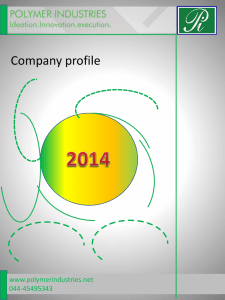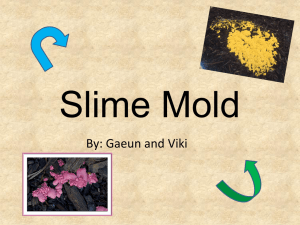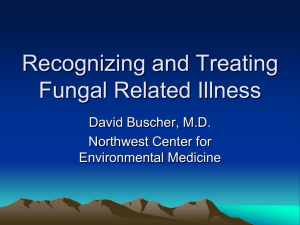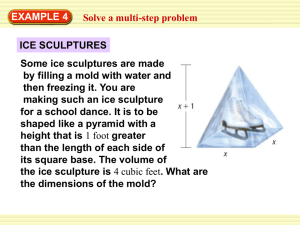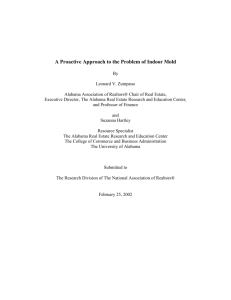View Attachment
advertisement
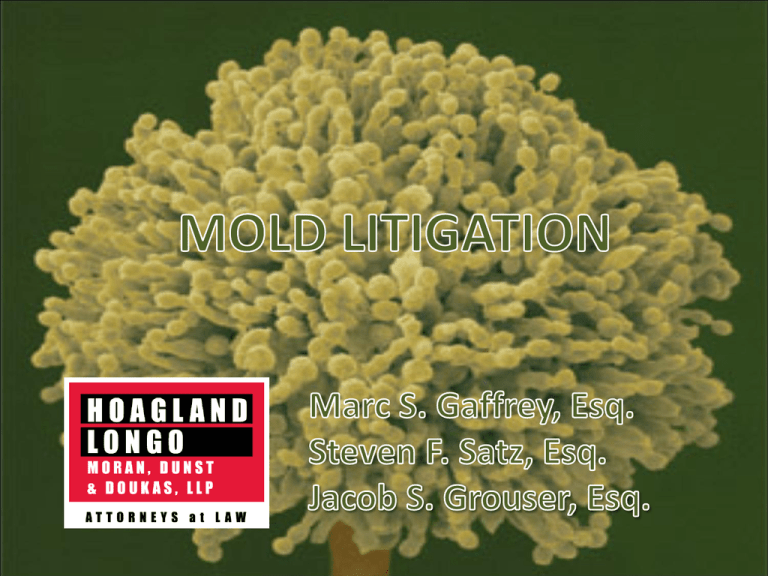
Introduction to Mold What is it? How is it caused? Introduction to Mold Most Common Stachybotrys Aspergillus Cladisporium Penecillium Trichoderma Introduction to Mold Where does it grow? Methods of Exposure Dermal Inhalation Ingestion Law Suits / Claims Personal Injury & Property Damage Law Suits / Claims Personal Injury Claims: Respiratory ailments Nose throat irritation Asthma Brain damage Skin rashes/dermatitis Hypersensitivity (multiple chemical sensitivity) Exacerbation of pre-existing conditions Allergies Memory loss CNS damage Headache Potential Claimants / Plaintiffs • • • • • • Home Owners Renters (residential and commercial) Commercial/Industrial Property Owners Invitees Employees Others Potential Defendants • • • • • • • • Property Owners Employers Builders / General Contractors Developers Sub-Contractors Remediation Contractors Landlords Design Professionals (A&E) • • • • • • • • • Building Managers Product Manufacturers PPE Manufacturers Realtors Sellers Inspectors HOA’s Carpet Cleaners Sampling Companies Types of Claims Failure to maintain Negligent selection of contractor Negligent design Negligent installation Negligent inspection Design defect (professional liability) Manufacturing defect Failure to address complaints (ADA) Breach of contract Breach of warranty Implied fitness/habitability Express warranty Types of Claims • Strict liability (mass produced and products) • Misrepresentation and/or fraud • Breach of covenant of quiet enjoyment / constructive eviction • Intentional infliction of emotional distress • Negligent infliction of emotional distress • Diminution in value • Loss of use • Punitive damages • Relocation • Lost rent • Wrongful death • Per quod claims Potential Defenses • • • • • Statute of Limitations Statute of Repose No Negligence/Foreseeability Medical/Liability Defense No Violation of Duty/Standard Early Claims Handling Settle or Assign to Defense Counsel? – Do you have all the information you need? • • • • • Diagnosis of a mold related condition Complete medical/occupational history Proof of liability Air samples/wipe samples Is remediation complete? – Were/are costs reasonable? • A reasonable demand? • Possibility of future claims? Assigning to Defense Counsel Initial Evaluation/Litigation Budget Identify what is missing that will allow you to settle the case or defend aggressively Obtain missing information Determine if experts will be needed Prepare budget How to set reserve Other considerations Discovery • Interrogatories – Not limited to the use of form interrogatories (toxic tort) • Request for Production of Documents – Get all documents from Plaintiff – Get documents from third parties • FOIA/OPRA Discovery • Geographic location of exposure – Flood plain – Industrial/Commercial Sites • Notice of mold causing condition (SOL) • Equipment used on site – sump pump – French drains – de-humidifier – air filters – HVAC • History of structure • Plumbing • Roof • Insulation • Foundation • Remodeling • Carpeting • Etc. Discovery (cont’d) • Remediation – Who did it – When it was done – Supporting Documentation – Notice • Description of Mold – Could be ordinary, non-toxic household mold • Cleaning agents and chemical used in home • Full occupational history • Smoking • Drug/Alcohol • Allergies – Pollen – Pets – Grass • Symptoms of injury claimed – What are they – When did they start – What treatment has been received – What records/testing are available Discovery (cont’d) • Complete Medical History – All records – X-rays – PFT’s • • • • Pharmaceutical History Out-of-pocket expenses Medical Wages • Previous injuries/lawsuits • Hobbies – Soil work • Cleanliness of exposure site Deposition Expand upon interrogatories and other paper discovery Get as much detail as possible Lock Plaintiff into a story Deposition (cont’d) Obtain impeachment/credibility information Arrests/convictions (fraud, dishonesty, moral turpitude & felonies) Previous depositions and testimony in court Relationship with parties Who the witness met with (when, where, how long, etc.) Who paid for travel Oral or written statements Documents or statements reviewed Preparation Who was present during meetings Selection of Attorney Ask for DL Types of Experts • Industrial Hygienist – Anticipates, recognizes, evaluates and controls health hazards in a work or home environment • Collects samples for analysis • Comments on the types of and amount of mold found • May be able to comment on sufficiency of exposure/dose response • Mycologist – Expert in the study of fungi • Can provide the same opinion as an industrial hygienist, but is more specialized • Pulmonologist – Specialist in diseases of the lungs and respiratory tract. • • • • Will be able to comment on Plaintiff’s respiratory injury Comments on link between mold and injury Comments on sufficiency of exposure/dose response Can provide theories as to alternative causation Types of Experts (cont’d) • Allergist/Immunologist – Physician who specializes in treatment of allergies • Will conduct IME • Skin test and blood test • Will comment on injury claimed • Toxicologist – Studies adverse affects of chemicals/substances on living organisms – Good for general and specific causation • Epidemiologist – Studies factors affecting health and illness of populations – Good for general causation – Can comment if substance can cause a particular illness only Types of Experts (cont’d) Engineers/Construction Experts Will Comment on cause of intrusion/liability Remediation Expert Will comment on the methods employed to remediate Will comment on the reasonableness of costs Real Estate Experts Will comment on the duty to disclose Will comment on loss of use and diminution Types of Experts (cont’d) Economist Will comment on lost wages Will comment on lost profits Inspectors Will comment on inspector negligence Will comment on building code and whether code was violated Geologists Studies the physical structure and processes of the earth Hydrogeologist A geologist that studies distribution and movement of groundwater in the soil and rocks of earth’s crust Will comment on whether groundwater or surface water was a cause or contributor of condition Most useful in professional liability claims Investigation of Mold Performed by Certified Industrial Hygienist (“C.I.H.”) Used to determine type and amount of mold present Must prepare chain of custody Use AIHA accredited laboratory Investigation of Mold Types of sampling Bulk Is it mold and is it actively growing? Can culture mold to determine species Surface samples Prep-lifting sample via tape (microscopic exam) Swab/wipe-rubbed with cotton and placed on culture plate (can collect dust samples also) Surface mold v. airborne mold Above methods show surface mold To investigate airborne mold, must conduct air sampling (all indoor environments have mold) Spore trap (air drawn across sticky surface) Impaction technique (spores drawn into a culturable medium) Compare indoor samples to outdoor samples Admissibility of Expert Opinions Frye versus Daubert versus Rubanick 1. Generally accepted within the scientific community 2. Relevancy and reliability based on scientific methodology a. Empirical testing b. Subject to peer review and publication c. Known or potential error rate d. Whether the theory and technique is generally accepted by a relevant scientific community 3. Acceptance of theory by a substantial minority Admissibility of Expert Opinions Does it really matter? Most studies have shown the result is the same whether Frye or Daubert applied Rubanick will allow more opinions get to the jury Presented by: Marc S. Gaffrey, Esq. Steven F. Satz, Esq. Jacob S. Grouser, Esq.


